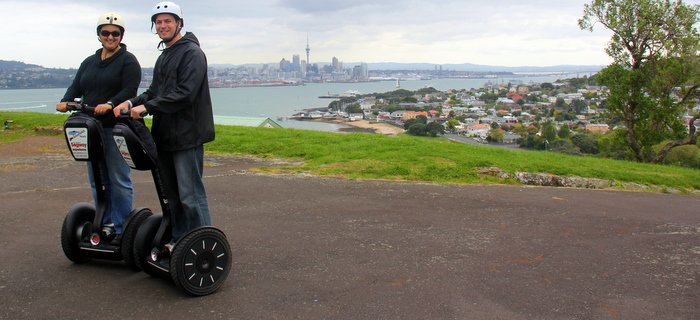Friday, October 28th, 2011: Auckland, New Zealand
There are those moments when you can recognize that Auckland, the largest city in New Zealand, is home to more than one-third of the country’s entire population. With its towering skyscrapers, morning commute traffic, and urban sprawl, it can certainly fit the description. Amongst the organized chaos of the big city, there are pockets of calm and quiet, and today we spent the day exploring the rugged beauty of a young volcanic island, Rangitoto, in the Hauraki Gulf and the laid back northern suburb of Devonport where we got our very first (and certainly won’t be the last) experience on a Segway transporter to tour the waterfront community.
We arrived into Auckland shortly after 7am. The weather was again gray and overcast, though the color of the sky seemed to have no direct impact on the temperature. It was comfortable, and our windbreakers served us well for the day’s activities. We enjoyed breakfast onboard and then made our way to the gangway to head just next door on the waterfront to the Ferry terminal. Today we were taking the Rangitoto Volcanic Explorer Tour offered by Fullers, a local tour operator.
The ferry to Rangitoto was scheduled for departure at 9:!5am. Though we faced a short delay as the ferry required an unscheduled fueling stop, we made good time over a calm gulf to the youngest island in the Bay, Rangitoto. At a young and tender age of 600 years old, this island was actually seen at its birth by the Maori people, making it only one of a small handful of complete land masses on the planet to share the distinction. Given its volcanic origins, we were prepared for a stark landscape covered in nothing but black pummice, much like the Big Island of Hawaii. Instead, we were pleasantly surprised to find something of a hybrid between the stark barren landscape of black rock and the lush greenery of a place like Kauai when we arrived.
Once we offboarded the ferry, we met our superguide for the day, Dennis, and he pointed us to our transport for the tour. Though we have travelled on many different modes of transportation thus far on the journey, today was a first. The passenger car looked much like the open air train cars from Disneyland, but the “locomotive” of this setup was little more than an industrial grade tractor with 4 foot high wheels. It did the job though, as Rangitoto has no “roads” and the tractor made its way along a specially designed path that permitted just a few inches of clearance on each side.
As we wound our way around the south coast of the island and turned towards the interior, Dennis provided us with information on the different flora and fauna of the area, along with background on the continued efforts to make this island, and its connecting neighbor Motutapu Island nature reserves for endemic species of plants, animals, and birds. Fortunately, given its remoteness in the gulf and providing nearly zero access to land-based pests, the program is making forward progress.
At the midpoint of the trip, we arrived at a boardwalk and staircase, that required us to take the final climb to the summit on foot. 380 steps later, we arrived at a 360 degree view of the entire region, seeing all the way back into Auckland, looking out on the northern suburbs, Waiheke Island (visited on our first visit to the area), and impressive views of Motutapu next door.
From here, we slowly came down from the island’s center and back towards the north and west coast to see a number of “Batches” or small holiday homes on the island. Back in the early 1900s as a way to make money, the local government signed leases with property owners and these small holiday homes were built on the island for families to come and vacation from time to time. These family homes were passed down from generation to generation and almost were eradicated from the island when the government took the island over as a conservation project in the 1930s. A short, but fierce battle ensued, and the outcome was that as long as there was family to pass the possession of the home from one generation to another, the lifetime leases would remain valid. Once the family lineage stopped (no heir), the lease was voided and the home was released to the government. Today, less than a dozen of the homes remain in private names, but they are still actively used and are featured as an interesting “place of historical reference” in the center of a nature reserve.
As we closed out our tour, we made our way back to the ferry and before its return to Auckland, the ferry makes a scheduled stop at the northern suburb town of Devonport. As we haven’t yet been here before, we hopped off and made our way through the small shpping center at the wharf and arrived at store #9, the home of Magic Broomstick Tours and 88.1FM Classic Gold Radio.
In one of the more curious pairings we have ever seen, the small shop was divided down the middle with an open view radio studio on the left and a small tour office on the right. Outside of Magic Broomstick were a few Segway transporters and we got our first look at our “wheels” for the afternoon tour.
Pauline, the owner of the shop and our guide for the day, was extremely pleasant, inviting, and immediately put us at ease. As she got our paperwork taken care of and presented us with helmets (compulsory) for the tour, the DJ in the booth next door was introducing the next set of music in his playlist and talking about the “great big ship” in the harbor bringing tourists to Devonport for the day and that they should stop by for a Magic Broomstick Tour! We smiled, pointed to ourselves through the glass, and he started to laugh on air as if he was single-handedly responsible for our sudden arrival.
We headed out of the small shopping center and to the rear of the building where Pauline had four Segways setup for our group (3 on tour and her own machine) and we were all introduced to the transporters, how they worked, and got some “hands-on” training. We learned how to stand on the Segways, balance our weight, and control them. It reminded us a lot of the WiiFit Balance Board when we played some of the video games at home, so we were pretty quick learners. After a few small exercises (winding our way through cones, going up and down curbs, and working on hills) we were ready to open them up and take the machines to their maximum allowed speed of 18.5kph (or 11mph).
The Segways quickly allowed us to travel down the main street of town, with Pauline pointing out several local historical spots. Then we continued along the waterfront and made our way towards the point, locally known at North Head. Along the way, we were subject to countless stares and waves from kids, and though we tried to acknowledge them all, there were those moments (in traffic, etc.) where you really just didn’t want to take your hands off the controls.
As we arrived at North Head, we found the Segways really began to shine beyond their novelty value, as the former miltary installation was situated at the top of a very large hill. The Segways knocked out the climb in little more than a few minutes, while on foot, the walk would have required a minimum of a half hour. At the summit, we were rewarded with more amazing views of the area and had the opportunity to tour the grounds on the Segways! Our guide took some pictures of us together on the hilltop and then it was time to begin our return to the ferry terminal. All in all, we had almost 2 hours on the Segways, between an extended training period and an 80-90 minute tour. Pauline and Magic Broomstick provided an exceptional afternoon in Devonport and we would highly recommend them.
Back on the ferry, we returned to the Auckland terminal and we completed the short walk back to the ship. It was slowly starting to hit us that 80 days previous, we had arrived into this amazing city to begin our great adventure, and now we were approaching the final days of the journey. The good news is that this will not be the last of our travels to New Zealand. It is simply a question of when we can return…



Leave a reply